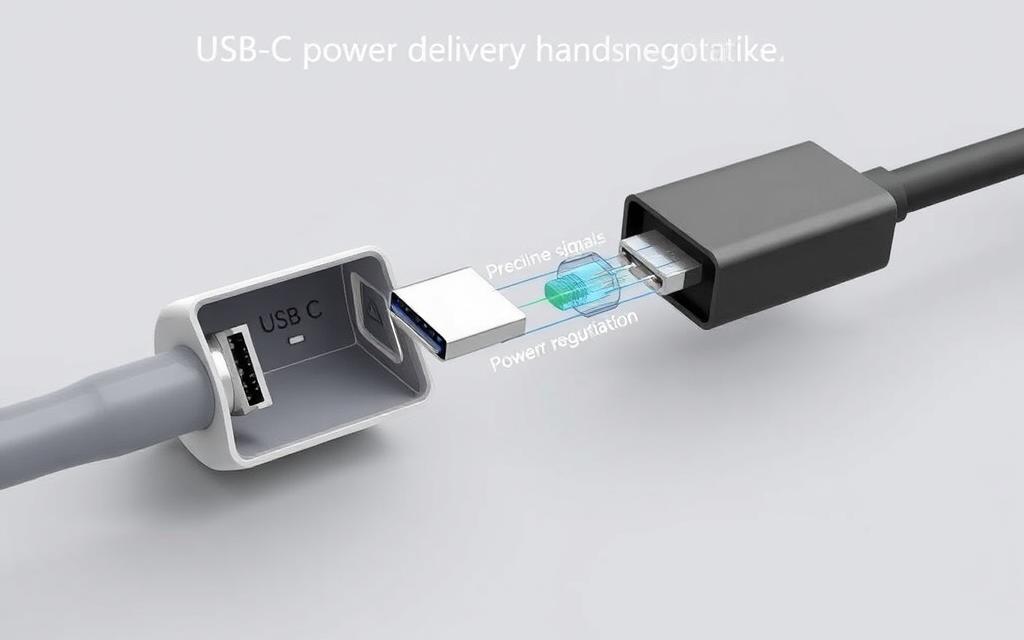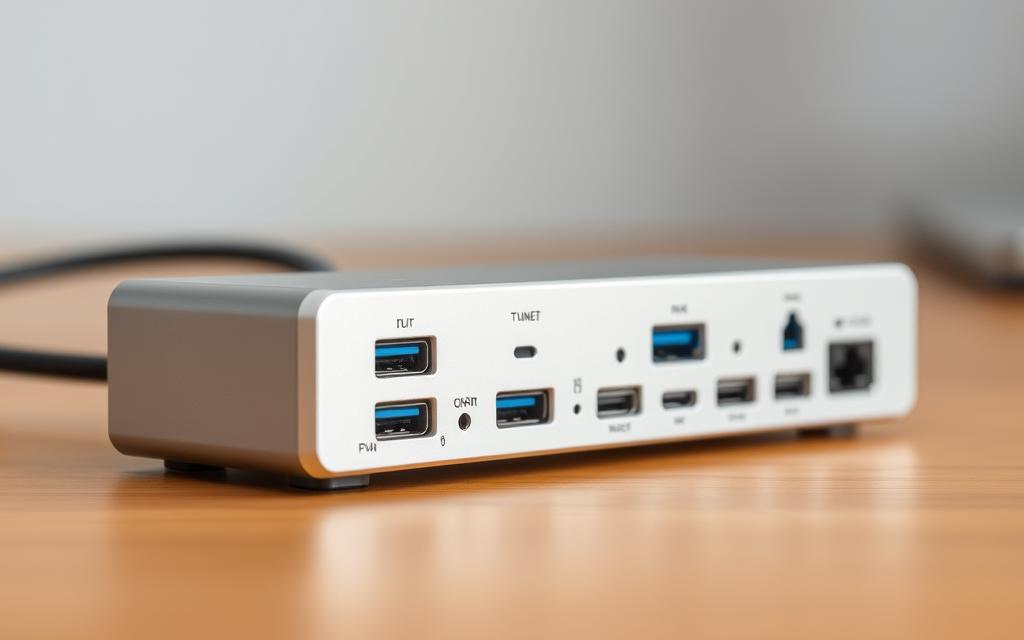Table of Contents
Many users wonder whether a functional battery is necessary when connecting to a Thunderbolt docking station. The answer depends on your setup. Desktop systems like the Mac Mini operate flawlessly without power negotiation, while laptops may behave differently.
Modern docking stations utilize USB-C Power Delivery protocols. This technology handles charging and data transfer through a single cable. Devices communicate their power requirements automatically, ensuring safe operation.
Popular models like the Ivanky FusionDock Max demonstrate this versatility. They deliver stable performance across various systems. Real-world tests confirm millions of successful connections, from powerful desktops to portable notebooks.
Understanding these power dynamics helps optimize your workspace. The next sections will explore technical details and practical scenarios for different computing environments.
How Thunderbolt Docks Work with Computers
Modern workspaces rely on efficient connectivity solutions. Thunderbolt docking stations act as central hubs, linking peripherals, displays, and networks through a single cable. This simplifies setups for both laptops and desktops.
Core Functions of a Thunderbolt Dock
These stations excel in three areas:
- Peripheral connectivity: Keyboards, drives, and audio gear connect via USB or Thunderbolt ports.
- Video output: Support for 4K/8K displays through DisplayPort or HDMI.
- Data transfer: Speeds up to 40Gbps enable rapid file sharing.
“Thunderbolt 4’s backward compatibility ensures seamless integration with older devices.”
Compatibility Across Devices
Laptops and desktops interact differently with docks. For example, iMacs utilize docks purely for connectivity, while MacBook Pros negotiate power. Thunderbolt 4 docking stations bridge these gaps with adaptive protocols.
Key differences include:
- Desktops lack power input on Thunderbolt ports, focusing on data.
- Laptops prioritize charging, requiring active power delivery.
Understanding Power Delivery in Thunderbolt Docks
The USB-C standard revolutionized how peripherals receive electricity. Its Power Delivery (PD) protocol enables dynamic energy distribution between hosts and accessories. This system ensures efficient charging without manual adjustments.

How USB-C Power Delivery Negotiates Charging
Devices initiate a digital handshake upon connection. The host evaluates power needs and available supply levels. This protocol dynamically adjusts voltage from 5V to 20V, optimizing energy flow.
Key steps in the process:
- Source capability advertisement: Docks declare available wattage.
- Sink request: Connected devices specify requirements.
- Contract agreement: Both parties lock in compatible settings.
| PD Version | Max Power | Key Feature |
|---|---|---|
| PD 2.0 | 60W | Fixed voltage profiles |
| PD 3.0 | 100W | Programmable power supply |
| PD 3.1 | 240W | Extended power range |
Why Desktops Like Mac Mini Don’t Draw Unnecessary Power
Unlike laptops, the Mac Mini acts as a power source. Its architecture bypasses energy requests when connected to docks. Protection circuits prevent overloads, making it ideal for stationary setups.
Intel-based systems differ slightly from M1/M2 models:
- M1/M2 chips: Integrated power management reduces idle consumption.
- Intel systems: Higher baseline draw but stable under load.
“USB4’s backward compatibility ensures docks work across generations without renegotiating power contracts.”
Do You Need a Working Laptop Battery for Thunderbolt Docking?
Lithium-ion technology transformed how laptops handle continuous charging. Unlike older NiCad batteries, modern systems intelligently manage power flow, making docks safer and more efficient.
Myths vs. Facts: Battery Dependency and Performance
Myth: “Calibrating batteries monthly improves docking reliability.” Fact: Li-ion controllers auto-balance cells, eliminating manual calibration. Apple’s macOS and Windows 11 optimize performance whether plugged in or not.
Older NiCad batteries suffered from “memory effect,” but Li-ion units thrive under steady power. Tests show no difference in speed between docked and undocked modes for M2 MacBook Pros.
Safety of Using Docks with or Without a Battery
Modern docks include safeguards against overcharging. HP confirms: “Our EliteBooks pause charging at 80% to prolong battery lifespan during desk use.”
“Continuous docking doesn’t degrade Li-ion batteries—heat and full discharge cycles do.” — HP Engineering Team
For emergencies, docks with passthrough power keep systems running smoothly. Always check your laptop’s thermal management settings to avoid throttling during heavy workloads.
Best practices:
- Store docked devices in cool, ventilated spaces
- Use manufacturer-approved stations for stable voltage
- Update firmware to fix early charging bugs
Conclusion
Today’s docking solutions adapt seamlessly to different setups. Whether using a laptop or desktop like the Mac Mini, modern stations prioritize safety through dynamic power negotiation. Protocols like USB-C PD prevent overloads, ensuring stable performance.
For optimal results, match your hub to workflow demands. Desktops excel with data-focused stations, while laptops benefit from charging-enabled models. Regular firmware updates resolve early compatibility quirks.
Future standards promise higher power delivery and smarter energy management. Until then, trust certified devices for reliable connections. Proper care—like avoiding extreme heat—extends battery and system longevity.
In short: Docking is safer and more versatile than ever. Choose wisely, and enjoy streamlined productivity.
FAQ
Can a Thunderbolt docking station function without a laptop battery?
Yes, Thunderbolt docks work without relying on a laptop battery. They draw power directly from the host device or external power sources via USB-C Power Delivery.
Do desktops like Mac Mini need a battery for Thunderbolt docking?
No. Desktop computers, including the Mac Mini, don’t require a battery since they receive continuous power from an AC outlet. The dock operates seamlessly through the Thunderbolt connection.
Does Power Delivery affect docking station performance?
Power Delivery (PD) ensures stable power distribution for connected devices. High-quality Thunderbolt docks negotiate power efficiently, maintaining optimal performance for monitors, storage, and peripherals.
Are there compatibility issues with different laptops?
Most modern laptops support Thunderbolt or USB-C hubs. However, older models may lack PD support, requiring external power adapters for full functionality.
Can a faulty battery disrupt docking station operation?
A failing battery might cause power fluctuations, but docks with stable PD protocols often compensate. For best results, use a functional power source or replace the battery.
Do Thunderbolt docks charge devices while in use?
Yes. Many docks support charging laptops and peripherals simultaneously, provided they offer sufficient wattage (e.g., 60W+ for most ultrabooks).









